How Hilaree Nelson and Jim Morrison Skied Lhotse
Nelson and Morrison are the first to successfully ski 7,000 vertical feet from the summit of NepalÔÇÖs Lhotse, one of the most prized high-altitude lines in the world
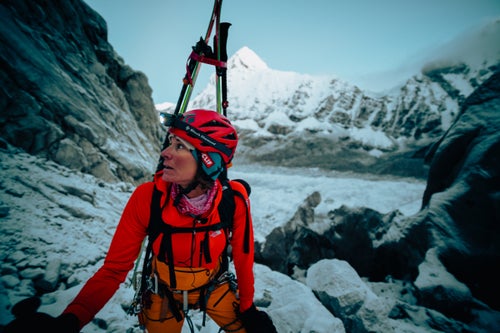
Big-mountain skiers╠řHilaree Nelson and Jim MorrisonÔÇÖs first turns on the summit of Lhotse, the fourth-highest mountain in the world, took commitment. The snow on the 27,940-foot╠řHimalayan╠řsummit was waist-deep and sugary, sloughing off a rocky pyramid at the top of the mountain. With a slope angle of 60 degrees and plenty of high-altitude exposure, this triangular╠řcliff was their entrance into the Lhotse Couloir, the iconic╠ř2,000-foot╠řnorth-facing line╠řthat makes this descent so coveted by skiers.
At 2:30 p.m. on Sunday, September 30, both Nelson and Morrison clicked into their ski bindings on the summit and became the first people to ski the Lhotse Couloir. Morrison dropped into the right side and made hop turns from the top. ÔÇťThere was just enough snow to make it possible,ÔÇŁ says Morrison.
Nelson arm-wrapped a rope and shimmied to get around the cliff. Then╠řboth skiers made calculated, careful turns into the fold of the couloir.
The rest of the 7,000-foot descent was direct and uncomplicated, save for the fact that they were skiing at such a high elevation and the snow conditions were ever changing. Morrison described the conditions as a ÔÇťmixed bag of tricksÔÇŁ that varied from ÔÇťrelatively good snow, to ice, to breakable crust, to windboard.ÔÇŁ
ÔÇťHalf our skis would be on this slippery wind slab and the other half would be buried in sugar,ÔÇŁ says Nelson.
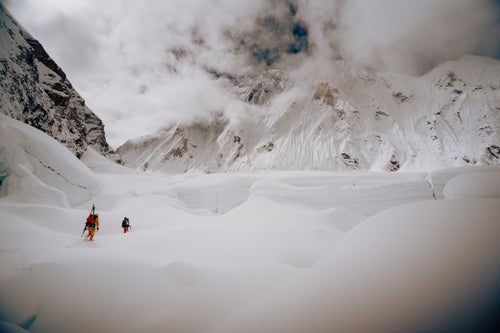
Both Nelson and Morrison had dreamed of skiing Lhotse for years. Morrison, who lives in Tahoe City, where he founded a luxury-home-building company, has long been an established skier and climber in the Sierra Nevada. Only in the past few years has he been pushing for bigger descents in higher mountainsÔÇömany of those projects, including skiing Makalu, Denali, and Papsura, he has done with Nelson. Nelson is one of the most accomplished expedition leaders and ski mountaineers in the world. In 2012, she became the first woman to climb two 8,000-meter peaksÔÇöEverest and LhotseÔÇöin 24 hours. Having climbed Lhotse before gave her familiarity with the mountain, which helped when she came back to ski it, she says.
The╠řLhotse expedition started at the very end of August, timed to coincide with the end of monsoon season and when snow would be covering the high peaks of NepalÔÇÖs Himalayas. Their groupÔÇöwhich included five Sherpas, two icefall doctors, and photographers Dutch Simpson and Nick KaliszÔÇöwas alone on the Everest Massif, a sharp contrast from the ever crowded peak climbing season in the springtime. From the beginning, their trip was challenging. The group had to set their own route and fix╠řlines. And weather delayed the arrival of gear and food. At one point╠řthey were uncertain if their skis would even arrive at╠řEverest Base Camp.
ÔÇťEvery part was hard and super challenging,ÔÇŁ says Nelson, reflecting on the expedition from her home in Telluride, Colorado. ÔÇťBut now that I step away from it, I see what a cohesive group we had in terms of the Sherpas, the cooks, and Nick and Dutch. We all managed to go that extra mile. The Sherpas especially worked so hard with the icefall doctors. ItÔÇÖs funny, in hindsight, how everything had to happen perfectly.ÔÇŁ
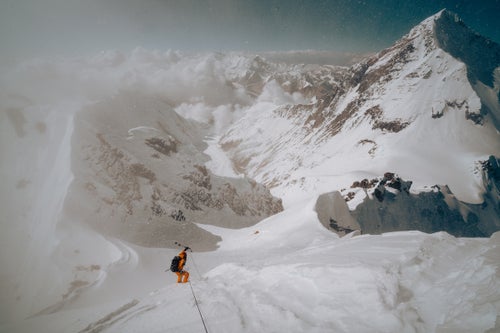
Nelson and Morrison said they could never have skied this first descent without their entire group. ÔÇťTo be the only team in the Western Khumbu, put all the routes in, and make it happen and get to the summit required a monumental effort from the whole team,ÔÇŁ says Morrison.
Palden Namgye Sherpa, the sirdar (or lead Sherpa), and two other╠řSherpas╠řset up fixed ropes to the top the day before Nelson and Morrison summited. Early in the morning on September 30, Nelson and Morrison started their push to the summit with Simpson, Kalisz, and Fu Tashi Sherpa and Ila Nuru Sherpa. ÔÇťThey helped so much with trail breaking and just smiling and being psyched,ÔÇŁ says Nelson. ÔÇťIt makes all the difference. It helps so much.ÔÇŁ
The climb to the top was cold and slow-going. They broke trail through ankle-deep snow that was punchy and slippery. Once they got into the couloir, the snow came up to their knees. ÔÇťThere was no break in it whatsoever,ÔÇŁ says Nelson. ÔÇťWhich is what makes it such a great ski.ÔÇŁ
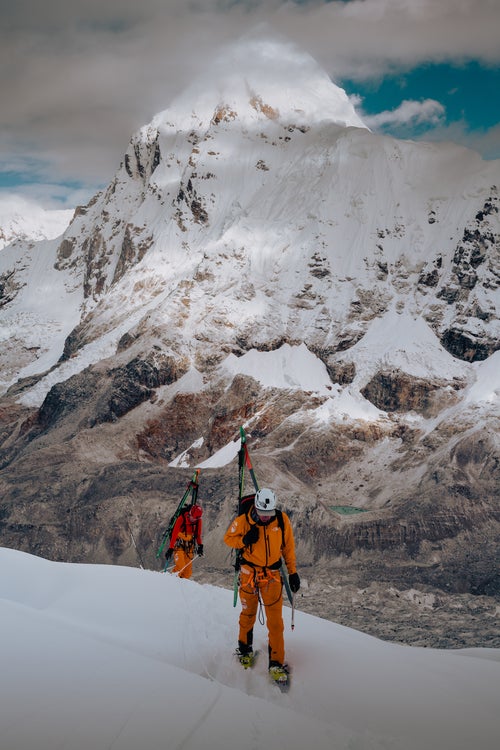
For the majority of their expedition, Nelson and Morrison did not use oxygen. But about 1,500 feet below the summit, they changed their minds and decided to strap on masks to help them push to the top.
ÔÇťIt was really hard for me, I really wanted to do it without oxygen,ÔÇŁ says Nelson, explaining that╠řthe mask makes her feel claustrophobic. But without it, Nelson says the climb to the summit would have taken five hours longer. At one point, they were crawling on all fours through deep snow in the middle of the couloir.
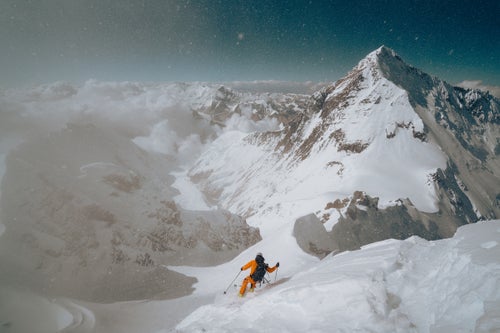
To descend, they used their skis, boots, and poles. They did not use ropes because they did not have to rappel. At one point, the pinch of the couloir was hardly wider than MorrisonÔÇÖs skis, but the two of them were able to shimmy back and forth to get through the ten-foot-long choke. The entire north-facing couloir was engulfed by shadows.
ÔÇťYour whole view in the couloir is this huge wall,ÔÇŁ says Nelson. ÔÇťYouÔÇÖre looking right at Everest. ItÔÇÖs dark and cold. As you come out of it, the whole aspect shifts to the west and you go from this narrow couloir to this massive faceÔÇöit must be a half-mile wide. It was totally in the sun.ÔÇŁ
Nelson and Morrison took off across the face, spreading out and making long links of turns. They laughed and enjoyed more relaxing turns to Camp III at 26,000 feet, where they took a break, drank some water, and packed up camp. But their day was not yet over. They still had another 5,000 feet to ski back to Camp II.
ÔÇťAt that point, the sun had gone away,ÔÇŁ says Nelson. ÔÇťThat was the steepest part of the descent and it had refrozen.ÔÇŁ
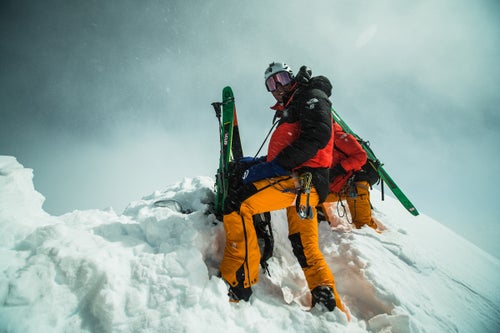
For the team, this historic feat was a dream come true. Standing on the summit of Lhotse with Nelson and their skis was a culminating experience, says Morrison. ÔÇťIt was monumental and epic and awesome to be skiing down from the Lhotse Couloir,ÔÇŁ he says. ÔÇťWe were pinching ourselves.ÔÇŁ
And though╠řNelson has set records on Lhotse before, this time╠řshe has the first descentÔÇöwithout the female qualifier.